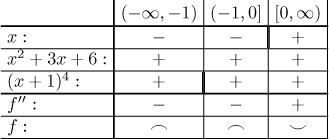Let f be a "reasonable" function, which here means that its domain consists of at most countably many intervals, on each of which the function is twice differentiable. We want to identify intervals of concavity and points of inflection.
Algorithm:
Step 1. Identify intervals of the domain of f.
Step 2. Find the second derivative f ′′. Find points
where
Step 3. For each of the intervals from Step 2, determine the sign of
the second derivative. General method: substitute a point from the interior
of such an interval into f ′′ to find the sign.
Special method for a second derivative that is a product and/or ratio of
factors: Determine the signs for each factor separately and then multiply the
signs using the standard sign algebra. This is best done using a table (see
Example below).
Step 4. Determine concavity from the signs of f ′′. The
function f is concave up on intervals where f ′′ is positive.
It is concave down on intervals where f ′′ is negative.
When writing the intervals in the answer, include endpoints where f is
continuous from the appropriate side.
Step 5. Determine points of inflection as points from the domain where
concavity changes.
For background for this algorithm see Concavity and inflection points in Theory - Graphing.
Example: Investigate concavity and inflection points of
![]()
Solution:
![]()
Dividing points:

Conclusion: f is concave down on
By the way, if you want to see how this function looks like, check out the Example in Methods Survey - Graphing - Overview).
Remark: The table method has one particular advantage, it is not necessary to substitute points from intervals into the derivative (or its factors). If a factor is linear, then it changes sign only once, namely at the point where this factor is zero. Thus it is enough to mark this dividing point in the table and then put one kind of a sign to the right and opposite signs to the left. Should it go − + or + −? That's easy to see, it is enough to substitute some number other than the dividing point, once can even ask what happens when x grows to infinity, does the factor become positive or negative? For more insight see Sign inequalities in the section Solving equations and inequalities in Extra.
For other examples see Concavity and inflection points in Theory - Graphing and appropriate problems in Solved Problems.